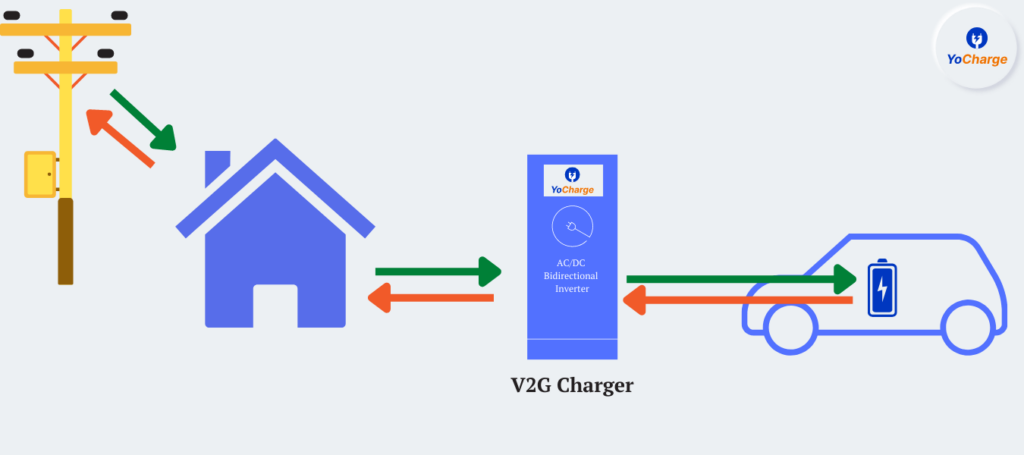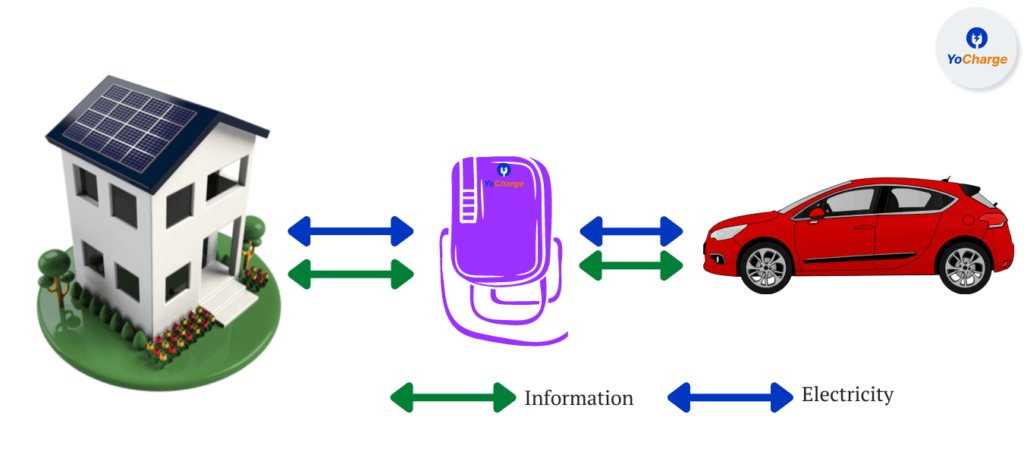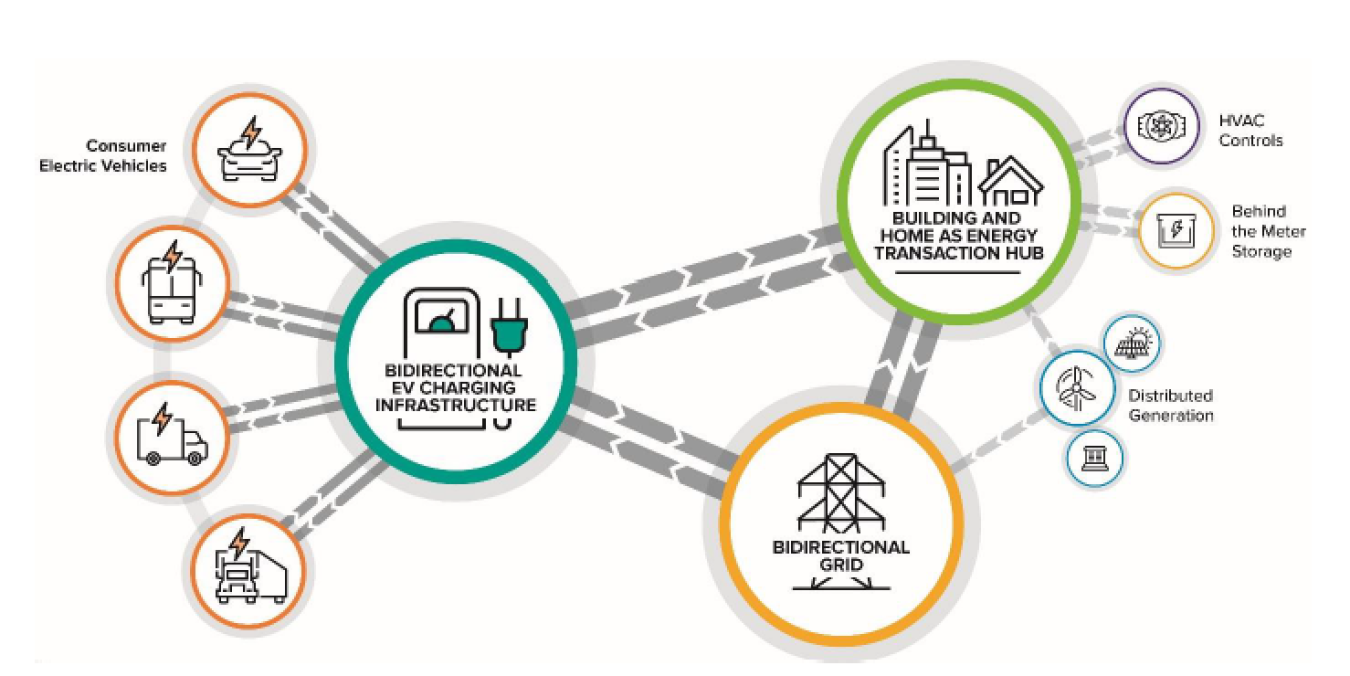V2G Charging Software
Vehicle to Grid (V2G) | Vehicle to Home (V2H)
In bidirectional (two-way) charging electricity can flow in both directions. While in a Conventional EV Charging power goes from the electric grid into the electric car in unidirectional (one-way). The Bi-directional Chargers allows current flow in and out of the electric car. Let us discuss more about bi-directional charging and its effects on electric vehicles.
Consequently, when the electric vehicle is plugged-in, the charging station offers backup power and can also be used as a generator, like a Tesla Powerwall. The Nissan Leaf and the Nissan e-NV200 are the only vehicles with V2G capabilities for now, although other manufacturers aren’t far behind. The F-150 Lightning electric pickup now has vehicle-to-home (V2H) capabilities, and Ford may add V2G charging in the future.
As a matter of fact, bi-directional charging does not reduce the lifetime of an electric battery. Instead it actually improves its efficiency.
Working of bi-directional charging
The charging of an electric car involves, the conversion of alternating current(AC) from the grid into direct current(DC). This conversion is either performed by an on-board charger or a charger in-built in an DC fast charger. There maybe a need for the energy stored in the battery. For this purpose, DC current is converted back into AC current.
Using the vehicle-to-grid technology, the energy stored in the electric car can be transferred to the electric grid. The curremt chooses the shortest path for its flow. To be more precise, the current flows to the closest destination.

V2G: Vehicle to Grid
Vehicle-to-grid (V2G) is a system in which plug-in electric vehicles (PEVs), such as battery electric vehicles (BEVs), plug-in hybrids (PHEVs), and hydrogen fuel cell electric vehicles (FCEVs), communicate with the power grid to sell demand response services by returning electricity to the grid or throttling their charging rate. EVs with V2G storage capability can store and release electricity generated from renewable energy sources like solar and wind, with output that varies based on weather and time of day.
When a bidirectional EV charger is used to supply power (electricity) from an electric vehicle’s battery to the grid via a DC to AC converter system commonly included in the EV charger, this is known as V2G. Smart charging can be utilized to help balance and resolve local, regional, and national energy needs. As a matter of fact, electric cars are parked at parking spaces during a large part of the day. At this instance, electric cars can be considered as large power banks for stabilizing electric grids.
The charger receives (EV charging mode) and supplies (EV discharge mode) electric energy to and from the network because it is bidirectionally connected to the network. In reality, not only can the two-way charger participate in V2G, but the unidirectional loader can also run the V2G service, which consumes network electricity .
Indeed, the growing market share of electric vehicles reflects a global concern about climate change. The administration has implemented a number of regulations to encourage the growth and adoption of electric vehicles, including ICE car purchase restrictions in major cities and subsidies for domestic electric vehicles and plug-in hybrid electric vehicles.
V2H: Vehicle to Home
Vehicle to Home (V2H) capability defines a situation in which a plug-in electric vehicle (PEV) not only receives power from the grid, but also supplies power to the home. During an outage, backup power is provided to an isolated load, such as a home during a power outage. Hence it behaves similar to that of a self – contained emergency generator.V2H capability is not the same as Vehicle to Grid capabilities. For instance in V2G, the vehicle transmits power in both directions for peak shaving or from/to a working electric power system auxiliary grid services
This is accomplished via a DC to AC converter mechanism, which is normally built within the EV charger. V2H, like V2G, can help balance and settle local or even national supply networks on a wider scale. For example, by charging your EV at night when there is less electrical demand and then using that electricity to power your home during the day, you can help to reduce consumption during peak periods when there is greater electrical demand and more grid pressure.
As a result, V2H can assist in ensuring that our houses have enough power when it is most needed. As a result, it may be possible to lower the overall strain on the power grid.

Advantages of Bi-Directional Charger
Vehicle-to-Grid (V2G) technology opens new opportunities for smart energy management and electricity trading. V2G technology unlocks the energy stored in electric vehicle batteries so that households and fleets can support the grid when demand peaks.
Let us discuss about the advantages of Bi-Directional Charger and its effects on energy savings:

1. Earn income from selling energy
Earn revenue from an EV if you have a bidirectional EV charger. You can sell extra energy in your EV’s battery back to the grid. Any energy gathered and stored in the battery of your electric vehicle (EV) can be sold back to the grid, whether it comes from your own energy source, such as solar panels on your roof, renewable load following, your home’s power source, or your local supermarket charger.
2. Make savings
You will be able to consume considerably cheaper energy than you would normally spend during those hours if you use the electricity stored in your EV to power your house during the day. This will result in significant reductions in your electricity bill over time.
Some energy companies are already offering EV owners off-peak or “differential” energy tariffs, in which you pay regular rates during the day but lower rates for a set number of hours at night. This is a strategy to help the grid balance. This ensure that not all EVs are charging at the same time during peak demand hours.
3.Stable power source into grid
The disadvantage with the existing renewable sources is that if we neither store or use it, it turns out to be a wastage. They are usually unstable and predictable. For instance solar panels work more effectively during daytime. Windmills are not able to provide power during a windless day. We may store excess renewable energy in vehicle batteries and use it when we need it, such as to meet a peak demand. By using, bi-directional charging a more stable and renewable source of energy is developed.
4. No power grid overload
During peak hours and high demand, the load on power grid increases. At these circumstances, electric vehicles can be used as a substitute. With bidirectional EV charging, the energy stored in EVs is directed to where it is most required, addressing local demands while also conserving the grid. Rather of pressuring the system during demand spikes, relying on electricity stored in EVs will keep it from becoming overloaded.
5. Energy management system with less investment
Bidirectional charging and V2G allow a building’s energy management system to be upgraded and made smart without having to start from scratch, saving money. Then, bidirectional charging lowers the cost of operating electricity. Plugged EVs can be utilized as temporary energy reserves instead of using extra energy from the grid because electricity circulates to the nearest spot where it is needed most.